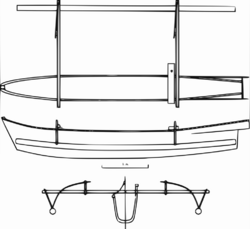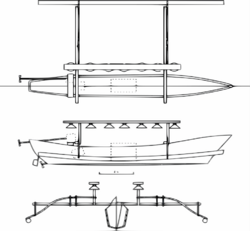Engineering:Pelang

Pelang or pilang is a traditional boat from Indonesia and Malaysia. It may refer to several different types of boats in the Nusantara, but commonly they refer to an outrigger canoe. The function differs from where they were used, from transporting people, fishing, to trading. Pilang has been known from at least the 14th century.[1]
Etymology
The name "pelang" can be traced from Old Javanese word pelang which means freight boat or a type of ancient merchant boat.[2]: 1350 The Great Indonesian Dictionary (KBBI) explains it as a "trading boat".[3]: 1039 According to M. Rafiek, a pelang is a rather large boat used to sail through the Java sea.[4]: 192

In northern Sulawesi, it was originally a term for a mahera boat (mahera means dugout—the base keel made from a whole piece of hollowed wood), but with the entry of Filipino technology (see vinta), then a boat made of plywood can also be referred to as a pelang.[5]: 3
Description
In the western part of Nusantara, it refers to a large, flat-bottomed canoe-like boat with one mast, stepping a lug sail made of cloth. Usually built of giam wood. H. Warington Smyth noted the dimensions of a pilang: About 42 ft (12.80 m) long, 5 ft (1.52 m) wide, 2 ft 3 in 2 ft 3 in (68.58 cm) draught, with 1 ft (30.48 cm) of freeboard. The capacity was 1 koyan (2.419 metric tons). The mast itself is about 40 ft (12.19 m) tall.[6]: 580
In Sejarah Melayu, two pilang is mentioned with size, one is 8 depa (12.8–16 m) long, the other is 12 depa (19.2–24 m) long.[7][8]: 36 [9]: 100
In the eastern part of Nusantara, the name refers to a small, canoe-like outrigger boat. On the northern coast of Sulawesi, pelang refers to an outrigger fishing boat. North Sulawesian pelang is about 6–8 m in length, 1 m in width, and crewed by 4–6 men. This pelang has an operational range of 5–7 mi (8.05–11.27 km).[10]: 104 The Mahera (dugout base) is a flat keel with a slight curvature. As it does not have enough height, additional side planks were added to improve the seaworthiness. They are made of marine plywood reinforced with frame construction and side beams. Modern pelang of northern Sulawesi were equipped with outboard motors. The motor gradually replaced the sail in the 1970s.[5]: 2, 5

There are also pelang that are equipped with lamps and electric generators for light fishing. Lights were used to attract fish for improving the quantity of the catch. The raw material is marine plywood with a length of about 7 m.[5]: 5
See also
References
- ↑ Ras, Johannes Jacobus (1968). Hikajat Bandjar: A Study in Malay Historiography. The Hague: Martinus Nijhoff. p. 234, quoting Hikayat Banjar, 1.2: "Then Ampu Djatmaka sailed with the same boat following it. Kapal and pilang are not as speedy as Si Prabayaksa; the size and the length and the ornamentation [of them] does not surpass Si Prabayaksa.", also Nugroho, Irawan Djoko (2011). Majapahit Peradaban Maritim. Suluh Nuswantara Bakti. p. 290: "Maka Ampu Djatmaka pun berlayar-layar dengan perahu yang sama mengikutkan itu. Kapal dan pilang itu tiada sama lajunya seperti Si Prabayaksa itu; besarnya dan panjangnya serta rupanya terlebih Si Prabayaksa itu."
- ↑ Zoetmulder, P. J. (1982). Old Javanese-English dictionary. The Hague: Martinus Nijhoff. ISBN 9024761786. http://sealang.net/ojed/.
- ↑ Departemen Pendidikan Nasional (2008). Kamus Besar Bahasa Indonesia Pusat Bahasa Edisi Keempat. Jakarta: PT Gramedia Pustaka Utama.
- ↑ Rafiek, M. (December 2011). "Kapal dan Perahu dalam Hikayat Raja Banjar: Kajian Semantik". Borneo Research Journal 5: 187–200.
- ↑ 5.0 5.1 5.2 Salam, Aziz (2018). "Technological Adaptation in Traditional Fisheries: Way to Survive". IOP Conf. Series: Earth and Environmental Science 139 (1): 012038. doi:10.1088/1755-1315/139/1/012038. Bibcode: 2018E&ES..139a2038S.
- ↑ Smyth, H. Warington (16 May 1902). "Boats and Boat Building in the Malay Peninsula". The Journal of the Society of Arts 50: 577.
- ↑ According to John Leyden's translation of Malay Annals, the second pilang is 15 fathom (27.43 m) long. See Leyden, John (1821). Malay Annals: Translated from the Malay language. London: Printed for Longman, Hurst, Rees, Orme, and Brown. p. 57.
- ↑ Brown, C.C. (October 1952). "The Malay Annals translated from Raffles MS 18". Journal of the Malayan Branch of the Royal Asiatic Society 25 (2&3): 1–276. https://archive.org/details/malay-annals-C.-C.-Brown/page/n1/mode/2up?q=.
- ↑ Kheng, Cheah Boon; Ismail, Abdul Rahman Haji, eds. (1998). Sejarah Melayu The Malay Annals MS RAFFLES No. 18 Edisi Rumi Baru/New Romanised Edition. Academic Art & Printing Services Sdn. Bhd.
- ↑ Saud, Lily S.N. (2007). Pirous, Iwan. ed (in id). Kearifan Tradisional Masyarakat Nelayan Kampung Batunderang Yang Berkaitan dengan Pemeliharaan Lingkungan Alam di Kabupaten Kepulauan Sangihe - Sulawesi Utara. Direktorat Jenderal Kebudayaan. https://books.google.com/books?id=Fmy7CgAAQBAJ&dq=perahu+londe&pg=PA104.
 |





